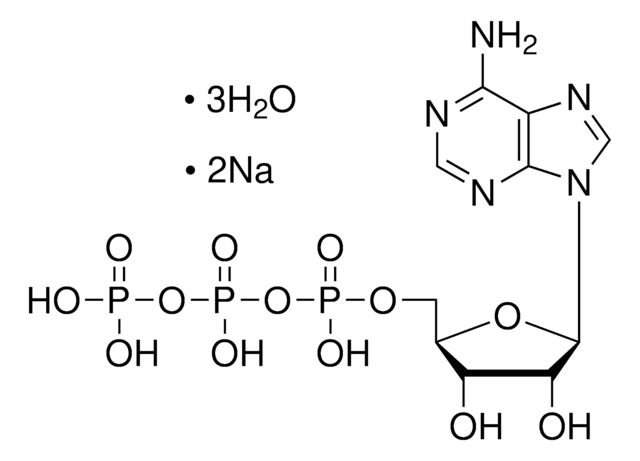P2645
Protein Kinase A Catalytic Subunit from bovine heart
≥9 units/μg protein (cyclic-AMP is not required for this activity), lyophilized (white powder to sticky mass to hard pellet)
Sinónimos:
PKA
Iniciar sesiónpara Ver la Fijación de precios por contrato y de la organización
About This Item
MDL number:
UNSPSC Code:
12352204
eCl@ss:
32160410
NACRES:
NA.32
form
lyophilized (white powder to sticky mass to hard pellet)
Quality Level
specific activity
≥9 units/μg protein (cyclic-AMP is not required for this activity)
mol wt
40,862 Da
storage temp.
−20°C
General description
Protein Kinase A enzyme is composed of two subunits- catalytic and regulatory. The catalytic subunit exists as a monomer in the presence of cAMP and has a molecular weight of 40,862 Da.
Application
Protein Kinase A (PKA) Catalytic Subunit from bovine heart has been used-
- to study PKA-mediated inhibition of IRK1 (inwardly rectifying K+) channels
- in in Vitro PKA pPhosphorylation assay
- in Vitro affinity binding assays
- to study effects of PKA on inspiratory drive currents in functionally active motorneurons
Biochem/physiol Actions
Protein Kinase A (PKA) controls the transduction of Hedgehog signaling and participates in proliferation and fate specification. It phosphorylates several neurotransmitter receptors, transcription factors and constituents of various intracellular signaling pathways.
Protein Kinase A catalyzes the transfer of terminal phosphate from ATP to threonine or serine residues present on various proteins. This protein is inactive in the absence of cAMP, where the catalytic and regulatory subunits are bound together. The regulatory subunit, in the presence of cAMP, binds to cAMP and releases the catalytic subunit.
Packaging
Package size based on phosphorylating units
Unit Definition
Phosphorylating Activity: One unit will transfer 1.0 picomole phosphate from ATP to hydrolyzed and partially dephosphorylated casein per minute at pH 6.5 at 30°C, determined by measuring the production of ADP.
Physical form
Lyophilized powder with sucrose and phosphate buffer salts as stabilizer.
Preparation Note
Prepared from protein kinase A (P 5511)
Disclaimer
Please note that the pack size has been changed to align with the unit definition, while the number of phosphorylating units remain the same as before.
inhibitor
Referencia del producto
Descripción
Precios
Storage Class
11 - Combustible Solids
wgk_germany
WGK 3
flash_point_f
Not applicable
flash_point_c
Not applicable
ppe
Eyeshields, Gloves, type N95 (US)
Certificados de análisis (COA)
Busque Certificados de análisis (COA) introduciendo el número de lote del producto. Los números de lote se encuentran en la etiqueta del producto después de las palabras «Lot» o «Batch»
¿Ya tiene este producto?
Encuentre la documentación para los productos que ha comprado recientemente en la Biblioteca de documentos.
Los clientes también vieron
Cyclic nucleotides in the nervous system
Basic Neurochemistry, 423-441 (2012)
F T Hartl et al.
The Journal of biological chemistry, 258(6), 3950-3955 (1983-03-25)
The physical and chemical properties of purified catalytic and regulatory subunits of type II cAMP-dependent protein kinase from bovine brain, skeletal muscle, and cardiac muscle were compared. The catalytic subunits from all three sources were identical with respect to molecular
Ken Tougane et al.
Plant physiology, 152(3), 1529-1543 (2010-01-26)
Abscisic acid (ABA) is postulated to be a ubiquitous hormone that plays a central role in seed development and responses to environmental stresses of vascular plants. However, in liverworts (Marchantiophyta), which represent the oldest extant lineage of land plants, the
Christopher M Bocchiaro et al.
The Journal of neuroscience : the official journal of the Society for Neuroscience, 23(4), 1099-1103 (2003-02-25)
Plasticity underlying adaptive, long-term changes in breathing behavior is hypothesized to be attributable to the modulation of respiratory motoneurons by intracellular second-messenger cascades. In quiescent preparations, protein kinases, including cAMP-dependent protein kinase A (PKA), potentiate glutamatergic inputs. However, the dynamic
E Wischmeyer et al.
Proceedings of the National Academy of Sciences of the United States of America, 93(12), 5819-5823 (1996-06-11)
Strongly rectifying IRK-type inwardly rectifying K+ channels are involved in the control of neuronal excitability in the mammalian brain. Whole-cell patch-clamp experiments show that cloned rat IRK1 (Kir 2.1) channels, when heterologously expressed in mammalian COS-7 cells, are inhibited following
Nuestro equipo de científicos tiene experiencia en todas las áreas de investigación: Ciencias de la vida, Ciencia de los materiales, Síntesis química, Cromatografía, Analítica y muchas otras.
Póngase en contacto con el Servicio técnico